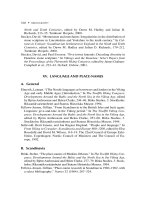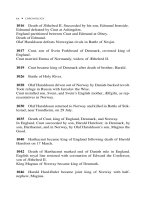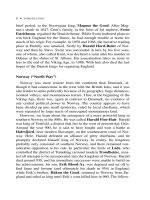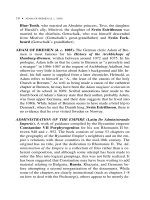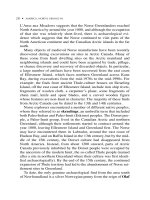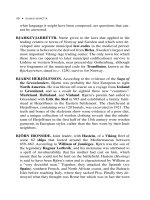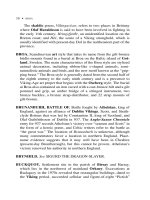The A to Z of the Vikings 3 pptx
Bạn đang xem bản rút gọn của tài liệu. Xem và tải ngay bản đầy đủ của tài liệu tại đây (61.11 KB, 10 trang )
1016 Death of Æthelred II. Succeeded by his son, Edmund Ironside.
Edmund defeated by Cnut at Ashingdon.
England partitioned between Cnut and Edmund at Olney.
Death of Edmund.
Olaf Haraldsson defeats Norwegian rivals in Battle of Nesjar.
1017 Cnut, son of Svein Forkbeard of Denmark, crowned king of
England.
Cnut married Emma of Normandy, widow of Æthelred II.
1019 Cnut became king of Denmark after death of brother, Harald.
1026 Battle of Holy River.
1028 Olaf Haraldsson driven out of Norway by Danish-backed revolt.
Took refuge in Russia with Jaroslav the Wise.
Cnut installed son, Svein, and Svein’s English mother, Ælfgifu, as rep-
resentatives in Norway.
1030 Olaf Haraldsson returned to Norway and killed in Battle of Stik-
lestad, near Trondheim, on 29 July.
1035 Death of Cnut, king of England, Denmark, and Norway.
In England, Cnut succeeded by son, Harold Harefoot; in Denmark, by
son, Harthacnut, and in Norway, by Olaf Haraldsson’s son, Magnus the
Good.
1040 Harthacnut became king of England following death of Harold
Harefoot on 17 March.
1042 Death of Harthacnut marked end of Danish rule in England.
English royal line restored with coronation of Edward the Confessor,
son of Æthelred II.
King Magnus of Norway became king of Denmark.
1046 Harald Hard-Ruler became joint king of Norway with half-
nephew, Magnus.
xx • CHRONOLOGY
1047 Svein Estrithsson, Cnut’s nephew, became king of Denmark.
Death of Magnus the Good.
Harald Hard-Ruler became sole king of Norway.
1066 King Harald Hard-Ruler of Norway killed in Battle of Stamford
Bridge.
William the Conqueror defeated English king, Harold Godwinsson, in
Battle of Hastings.
Magnus Haraldsson became king of Norway.
1067 Olaf the Peaceful became joint king of Norway with brother
Magnus.
Ari Thorgilsson, author of Book of the Icelanders, born in Iceland.
1069–1070 Svein Estrithsson invaded England.
Death of Magnus Haraldsson.
Olaf the Peaceful became sole king of Norway.
1074 Death of King Svein Estrithsson of Denmark. Succeeded by son,
Harald Hén.
Adam of Bremen finished History of the Archbishops of Hamburg-
Bremen.
1075 Last Danish invasion of England by Knut II.
1079 Godred Crovan became king of Man after victory at Battle of
Skyhill.
1080 Death of Harald Hén of Denmark. Succeeded by Knut II.
1085 Knut II of Denmark planned invasion of England.
1086 Murder of Knut II of Denmark in Odense. Succeeded by half-
brother, Olaf Hunger.
1095 Death of Olaf Hunger. Succeeded by half brother, Erik Eje-
good.
CHRONOLOGY • xxi
1098 King Magnus Bare-Foot of Norway’s expedition to Norse
colonies in the west.
Deposed earls of Orkney; captured king of Isle of Man; defeated the
Normans off Anglesey, and signed treaty with king of Scotland.
1103 Death of Magnus Bare-Foot in Ireland.
xxii • CHRONOLOGY
Introduction
1
The Vikings, those medieval Scandinavian warriors who launched fero-
cious and much-lamented attacks on western Europe, continue to evoke
vivid images and lively public interest today, some 1,200 years after
they first came to the attention of contemporary monastic chroniclers.
One only has to search for the word Viking on the Internet to realize the
extent of this enduring popularity and to see just how valuable a com-
modity it has become in 21st-century commerce and tourism. This is
perhaps rather surprising given that popular images of the Vikings
nearly always begin with swords, axes, helmets (see weapons), ships,
pillage, looting, and of course slaughter and destruction. This bad press
dates right back to the earliest sources for the Vikings, where the Chris-
tian victims of their attacks complained about the destruction inflicted
on their churches and congregations, and perhaps this supports the idea
that there is no such thing as bad publicity!
However, the enduring interest in the Vikings lies not only in their
reputation as barbarians who harried the Christian civilization of west-
ern Europe. In the 19th century, Romantic artists, musicians, and writ-
ers were interested in the heroism of these warriors, who were free and
unbound by the constraints of later feudal structures, who were loyal to
their brothers-in-arms, who would continue to fight even if the odds
were against them, and who sailed overseas in search of adventure. This
heroic Viking figure was equipped with appropriately dramatic trap-
pings, most notably the horned or even winged helmet (which in fact
seems to have had a ritual rather than battle purpose in early Germanic
cultures) and the double-headed battle-ax. Translations of Icelandic
sagas allowed international audiences to read about the pioneering so-
ciety established by these Vikings in the North Atlantic: a collection of
free men, ruled by their own laws rather than a king, on the very fringes
of the habitable world—a society that had undoubted appeal to Europe
and North America, where new ideas of personal liberty and universal
suffrage were beginning to take hold.
Under the impact of modern scholarship, particularly archaeological
excavations, this image of the free and heroic Viking has been supple-
mented with other, perhaps more everyday, images. The raider might
also have been a trader, who traveled about selling goods, and a
colonist, who left his homeland behind him and began a new and peace-
ful life in a different country. Archaeological finds have revealed that
Viking craftsmen produced elaborate and beautiful jewelry and sculp-
ture, as well as weapons, and the technical skill of the Viking shipwright
was second to none. There are also the large numbers of Scandinavians
who chose to stay at home, those who supported the conversion of their
compatriots to Christianity, and the social groups neglected by written
sources: women, children, the poor, and the enslaved. None of these
Vikings are so attention-grabbing as the more dramatic warrior figures,
but our knowledge about these people and their lives certainly helps to
paint a more complex and realistic image of the period and also to ex-
plain why people continue to find the Viking Age a compelling and fas-
cinating period to study.
DEFINITIONS: VIKINGS,
THE VIKING AGE, AND SCANDINAVIA
This is a historical dictionary of the Vikings, but who were the Vikings?
The word Viking has come to be used in a general sense for those people
from the area covered by the modern Nordic countries of Denmark, Ice-
land, Norway, and Sweden in the historical period c. 800–c. 1100. How-
ever, strictly speaking, Viking is not merely another way of referring to a
medieval Scandinavian. Technically, the word has a more specific mean-
ing, and it was used (only infrequently by contemporaries of the Vikings)
to refer to those Scandinavians, usually men, who attacked their contem-
poraries. There were also large numbers of those people who sailed across
the North Sea, the Baltic, and down the Russian rivers into the Black Sea
and beyond, trading and settling as well as raiding (see Viking).
The activities of these people led historians to name the period in
which they undertook raiding, trading, and colonizing as the Viking
Age. As with all historical epochs, the Viking Age is an artificial schol-
2•INTRODUCTION
arly construct; for example, in English scholarship, the first recorded
raid on the monastery on Lindisfarne in 793 marks a convenient start-
ing point, and the Norman Conquest, in 1066, has been selected as a
suitable end to the Viking Age. The Concise Oxford Dictionary (9th ed.
Oxford: Oxford University Press, 1995) therefore defines a Viking as
“any of the Scandinavian seafaring pirates and traders who raided and
settled in parts of NW Europe in the 8th to the 11th c[enturies].” How-
ever, in Scandinavia itself, there are no contemporary written sources
that allow historians to select a particular date as either a beginning or
an end to the Viking Age, so here the periodization is much more of an
approximation, covering the years from c. 750 to c. 1100.
For the purposes of this dictionary, this longer time span (c. 750–
c. 1100) will be used. Although, strictly speaking, Scandinavians who
stayed at home during this period were not Vikings, to study the Vikings
without making reference to their compatriots and their home life would,
of course, be meaningless. Even Vikings were not always Vikings, for it
often appears to have been a seasonal activity, undertaken in the summer
when the seas were relatively calm, while winters were spent at home in
Scandinavia. Therefore this dictionary will actually focus on the archae-
ological, art historical, epigraphical, historical, linguistic, and literary ev-
idence for Scandinavia and Scandinavians in the Viking Age. It has also
been necessary to include separate entries on some historical figures who
were not Scandinavians, but who had considerable interaction with
Scandinavians; for example, to omit a separate entry for King Alfred the
Great, who spent much of his reign repelling Scandinavian raiders,
would be pedantic, even though he is not of course a Viking in any sense
of the word. By the same token, there is much in this dictionary that
postdates the Viking Age: apart from runic inscriptions carved on to me-
morial stones, all the Scandinavian written evidence for the society,
economy, politics, personalities, and culture of the Viking Age comes
from the medieval period. Although the value of these sources to histo-
rians of the Viking Age is not straightforward, to omit references to Ice-
landic sagas or Eddic poetry because they were written down in the
13th and 14th centuries, for example, again would be taking an unnec-
essarily narrow view of the Vikings. Any student of the period has to use
these sources, imperfect as they may be.
It is also necessary at this point to discuss the meaning of the word
Scandinavia. Scandinavians use this word to refer to the three present-day
INTRODUCTION •3
countries of Denmark, Norway and Sweden; in other words, both Iceland
and Finland are excluded from this definition of Scandinavia. The Scan-
dinavian word to describe all five of these present-day countries is
Norden, which can be loosely translated into English as “the Nordic coun-
tries.” This usage of the term Scandinavian has been followed in this dic-
tionary: certainly Finland was and indeed is ethnically and linguistically
quite distinct from the other four countries, which during the Viking Age
spoke a common language, known to contemporaries as dönska tunga or
norrænn. In fact, very little is known about Finland during the Viking
Age, and although Scandinavians heading east are likely to have traveled
through the country, there is little evidence that they spent much time
there. At the beginning of the Viking Age, Iceland was of course not part
of the Scandinavian world, but it was colonized by a Scandinavian-
speaking population in the ninth century and maintained close contacts
with Norway, in particular. Although Iceland is therefore ethnically and
linguistically part of the Scandinavian world, there are significant differ-
ences that placed it outside the Scandinavian mainstream: politically, it
was not a monarchy—at least not until it acknowledged the Norwegian
king, Hákon Hákonarson, as its king in 1262–1264; ethnically, there ap-
pears to have been a small but significant Celtic strand in the Icelandic
population, following the settlement of some Scandinavian families who
had previously spent time in parts of the British Isles; economically, it
lacked its own towns during the Viking Age and was instead dependent
on trade with Scandinavia; and geographically, it was, of course, a con-
siderable distance from Denmark, Norway, and Sweden. Nevertheless,
although Iceland is not treated as part of Scandinavia per se in this
dictionary—it is a crucial piece in the puzzle of the Viking and the Viking
Age—as it was of course here that a flourishing literary and historio-
graphical culture developed in the Middle Ages.
GEOGRAPHY AND HABITAT
Although Scandinavia is a convenient umbrella term for the three
present-day countries of Denmark, Norway and Sweden, lying on the
northern edge of the European continent, it masks significant differ-
ences between these three countries. Most fundamentally, the geogra-
phy and topography of Scandinavia varies considerably. This is hardly
4•INTRODUCTION
surprising given that Scandinavia stretches from the base of the Jutland
Peninsula in the south (about 55º latitude) to Nordkapp or North Cape
in the north (71º latitude). Geographically and topographically, Norway
and Denmark are totally different. While Denmark is just approximately
375 kilometers from north to south, Norway measures about 1,770 kilo-
meters. Similarly, in contrast to the predominantly flat, arable lands of
Denmark, only one-fifth of Norway lies below 150 meters. Most
of Norway is marked by high mountains that are cut by long, narrow
valleys that follow the fjörds, and the only region that can be described
as coastal lowland lies in the area surrounding Oslo. Sweden, like Nor-
way, is a long country, stretching from the Baltic in the south to beyond
the Arctic Circle, and conditions within this area vary considerably.
There are larger tracts of flat, arable lands in Sweden than there are in
Norway, but also much uncultivable marshland and forest. Communi-
cations with inland areas in Sweden were difficult as, unlike Norway,
there were no fjörds to provide a relatively quick and easy means of
transportation, and the climate of northern Sweden did not benefit from
the Gulf Stream that warmed the north Norwegian coast. These geo-
graphical and topographical conditions played a crucial part in the de-
velopment of Scandinavia during the Viking Age.
THE VIKINGS AT HOME
The most visible and obvious characteristics of the Viking Age are the
expeditions that the Vikings undertook in their ships, across seas and
along rivers. The Viking Age is when Scandinavia really made its en-
trance on to the stage of European, indeed world, history. However, at
home in Scandinavia, the Viking Age also saw important changes and
developments, many of which were partly the result of increased con-
tact with Europe: Scandinavian kings sought to establish themselves as
the rulers of more clearly demarcated and unified kingdoms, modeling
themselves on European rulers such as Charlemagne, emperor of the
Franks; Christianity and the institutions, liturgy, and learning of
the Catholic Church were introduced to Scandinavia, replacing pagan
beliefs and rituals; and the growth of trade with Europe and beyond led
to a degree of urbanization in Scandinavia, as well as an increased
awareness of European politics, society, and culture.
INTRODUCTION •5
At the start of the Viking Age, Denmark, Norway, and Sweden did
not exist as three separate kingdoms; instead there appear to have been
a number of regional chieftains in each “country” who ruled over the in-
habitants of smaller districts. Politically, the Viking Age is characterized
by the gradual centralization of power into the hands of a much smaller
number of kings and the emergence of political units known as Den-
mark, Norway, and, somewhat later, Sweden. This development was
uneven across Scandinavia: already, at the beginning of the Viking Age,
there is evidence that there were some people claiming to be kings of
“Denmark,” but in Sweden, no king had effective power throughout the
whole country until well after the end of the Viking Age. Afinal and fur-
ther point here is that the borders of the modern Scandinavian countries
of Denmark, Norway, and Sweden differed from those in the Viking
Age. Most importantly, the part of southwestern Sweden that is today
the province of Skåne was, in fact, part of the kingdom of Denmark
throughout the Viking Age.
Denmark (“Land [March] of the Danes”)
At the beginning of the Viking Age, the peninsula of Jutland appears
to have been the most important part of Denmark. There is archaeolog-
ical evidence for a number of important and large-scale building works
in eighth-century Jutland that suggest that there was already someone in
the area powerful enough to organize this work. For example, the town
of Ribe was founded c. 700; the Kanhave Canal was constructed on
the island of Samsø c. 726; and, most significantly, around 727 building
work on a long fortification, known as the Danevirke, running across
the base of Jutland, was begun. It provided a defensive line where the
naturally marshy terrain did not and consisted of large turf and timber
ramparts. This suggests that someone with considerable political and
economic power in Jutland was worried by expansion from Germanic
tribes to the south into Danish territory, and that, already at this period,
there were some political attempts to differentiate Denmark from the
European mainland.
Much of our knowledge of the early history of Viking-Age Denmark
comes from continental chronicles, reflecting in particular the close ge-
ographical relationship between Denmark and the kingdom of Frankia.
Frankia is the name given to the kingdom that, roughly speaking, cov-
6•INTRODUCTION
ered the area of present-day France and Germany, and at the beginning
of the Viking Age it was ruled by the Emperor Charlemagne from his
capital in Aachen (in present-day Holland). The province of Saxony, on
the southern border of Jutland, was taken over by the Frankish emperor
in the eighth century, bringing this expansionist power right onto Den-
mark’s doorstep. The Royal Frankish Annals record a Danish king
called Godfred, who was in power around 800–810, and who attacked
Charlemagne’s Slavic allies. Godfred is also said to have settled mer-
chants in the early Viking-Age town of Hedeby. Two other ninth-
century Danish kings, called Horik the Older and Horik the Younger,
are known (see Horik). Horik the Older allowed the German mission-
ary, Ansgar, to build churches in Hedeby and Ribe in the 850s. Like
Godfred, they were also involved in continental politics and launched
an attack on Hamburg. However, for much of the second half of the
ninth century and the early 10th century virtually nothing is known of
events taking place in Denmark or of the power struggles that were
probably taking place between various chieftains. Then, in the middle
of the 10th century, a new Danish royal dynasty appears, that of Gorm
the Old, based in Jelling in central Jutland. This family appears to have
won total political dominance in Denmark, and the current queen of
Denmark, Margrete II, can in fact trace her ancestry right back to Gorm.
Gorm is thought to have died in the 950s. Not very much is known
about him or the events of his reign in Denmark, but it is clear that he
was buried in a large burial mound at Jelling. At Jelling, there is also a
commemorative inscription, carved in runes, that was commissioned by
Gorm’s son and successor, Harald, who is usually known as Harald
Blue-Tooth. In 987, Harald was deposed by his own son, Svein, who
had the nickname Forkbeard. Svein Forkbeard was involved in many
of the Viking campaigns in England and died in Gainsborough (Lin-
colnshire) in 1014, after having defeated the English king, Æthelred II
the Unready, and having won control of the kingdom of England. Two
years later, in 1016, Svein’s son, Cnut I the Great, became king of
England, and two years after that, in 1018, Cnut also succeeded his
brother (Harald) to the Danish throne. Cnut became king of a great “em-
pire,” which at its maximum extent included Norway and possibly even
parts of southwest Sweden, as well as Denmark and England. This em-
pire started to crumble before his death in 1035, and after he died, Den-
mark went briefly to his son Harthacnut, before passing, for an equally
INTRODUCTION •7
